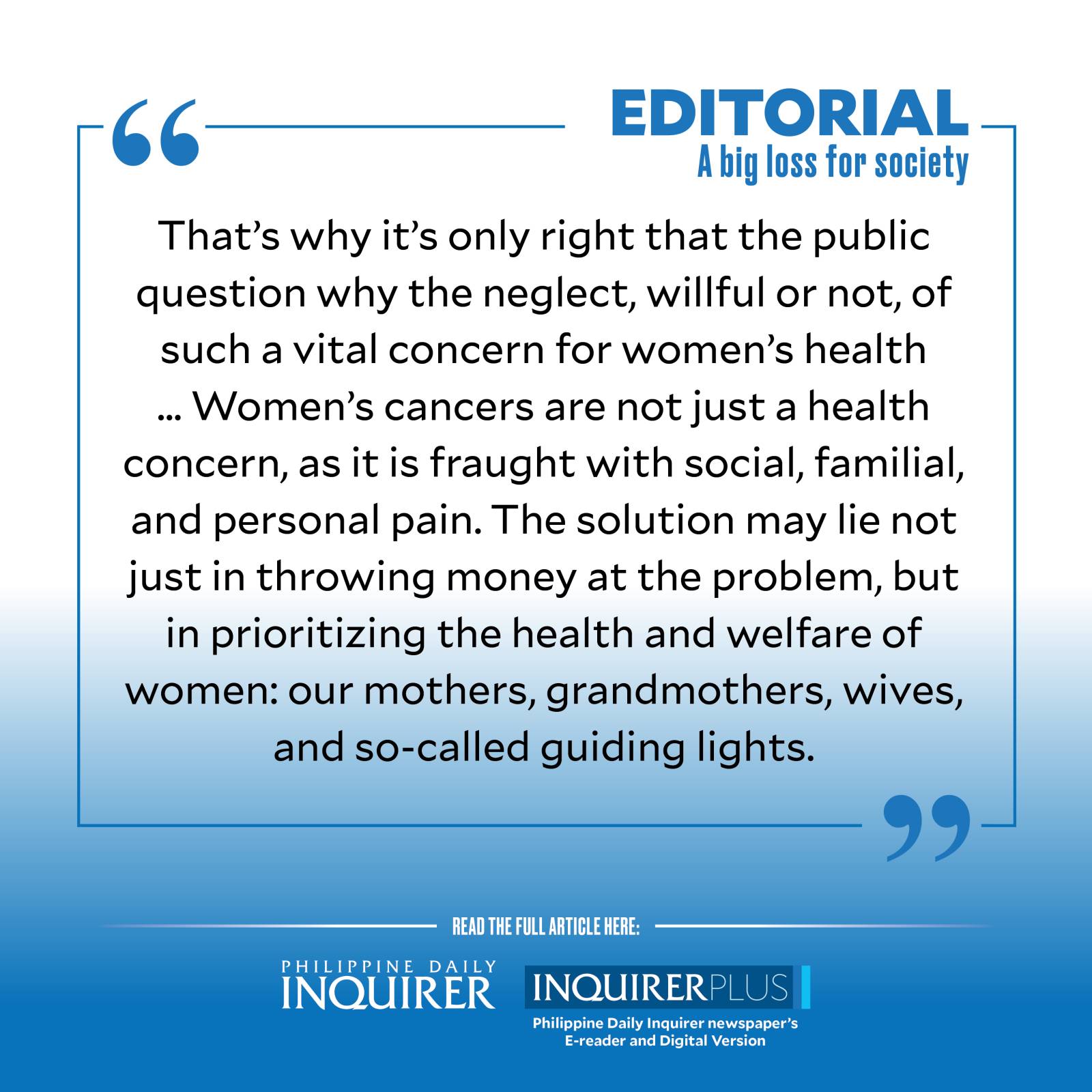A big loss for society

A lot of women have a health and beauty routine: a weekly manicure and pedicure, regular visits to a parlor for a haircut, and, for some, regular massages or visits to a spa, along with a plethora of other services like facials, hot oil treatments, and hair coloring.
Sadly, such vigilance and high maintenance routine isn’t followed by other concerns, like health.
A recent report discloses that only one percent of Filipino women have been screened for breast and cervical cancer, the top two cancers among Filipino women.
Valerie Gilbert Ulep of the Philippine Institute for Development Studies (PIDS) which released the report, bemoaned that “We are diagnosing cancer patients at a very, very late stage.”
Indeed, the toll of breast and cervical cancer is heavy, with around 27,000 new breast cancer cases reported in the country each year and 9,000 women dying annually, according to the PIDS.
This need not be the case. Mammograms, the standard screening test for breast cancer, and pap smear and newer methods are offered at competitive rates. The PIDS, however, noted that few government hospitals offer cancer screening due to lack of funds. This accounts for the low cancer screening especially for the poor.
Then, too there is the lack of even basic information for public awareness, with few women aware of the threat of breast and cervical cancer and the need to go for early screening.
The Department of Health’s (DOH) public information section seems to have its obvious mission, a little late but still doable. Aside from the cost of the screening, women are also reluctant to do the examinations for fear of finding a positive diagnosis, said Ulep. Patients go for screening “when they are already suffering and it is too late,’’ he said.
Cancer Coalition Philippines vice president Carmen Auste said in a recent forum that some of the challenges in cancer diagnosis come from the patients themselves as well as medical practitioners, who lack knowledge about the signs and symptoms of cancer.
There is also a need to improve the system of referral of patients from rural health units to hospitals, she said. ‘’We’re scared to have ourselves checked because we think we don’t have funds for it,” Auste said.
This is truly unfortunate as early screening would have given the cancer patient enough time to adjust to therapies that would have at least delayed, if not eliminated the threat of cancer.
And poverty is not even a credible excuse for the failure of a cancer program. Cambodia and Myanmar, which are considered lower-middle income countries like the Philippines, have “better” cancer screening rates, Ulep said.
In Malaysia and Thailand, which are considered upper-middle income countries, the screening rate is 20 percent. Yet “they are worried that their rates is low,” Ulep said, adding that in high-income countries, the cancer screening rate is around 50 percent.
That’s why it’s only right that the public question why the neglect, willful or not, of such a vital concern for women’s health. Why the lack of priority on the part of the DOH? Shouldn’t this be a key part of the new DOH secretary’s program of action?
As Philippine Society of Medical Oncology president Dr. Rosario Pitargue noted, cancer is not a death sentence anymore with advances in cancer treatment and management. But surviving cancer requires early diagnosis, and the right treatment and support.
The passage of Republic Act No. 11215 or the National Integrated Cancer Control Act in February 2019 is a long-awaited law to help cancer patients avail of treatment and survive. But the DOH and the various local government units must also focus on prevention, which can be accomplished through early screening and detection. This is not only more economical but will also save a lot of lives.
Breast and cervical cancers take particularly heavy toll on not just women, on their families as well. Ulep said deaths come from cancer patients who are relatively young, between 40 and 69 years old, “resulting in untold social and economic costs to the country.” Remember, these are the years women raise their children or else are pursuing economic activities to help their families.
Then, even after the patient’s death, the impact and consequences continue with children orphaned of one parent having to cope with grief, loss, regret, and maybe even the division the family if the father proves incapable of looking after his children.
Women’s cancers are not just a health concern, as it is fraught with social, familial, and personal pain. The solution may lie not just in throwing money at the problem, but in prioritizing the health and welfare of women: our mothers, grandmothers, wives, and so-called guiding lights.




















